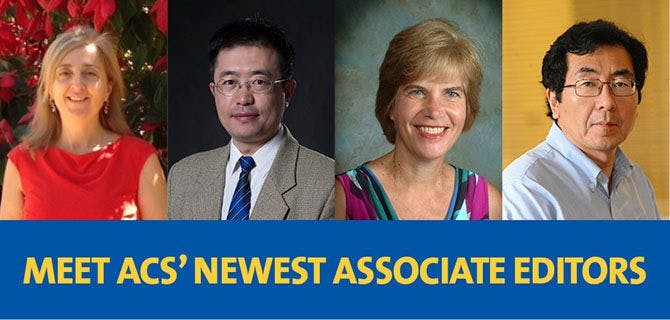New associate editors bring more than just changes to a publication’s masthead. They bring new experiences, new perspectives and new ideas to their publications. Get to know some of ACS’ latest associate editors and learn what unique gifts they’ll be bringing to their respective journals. *** Maria Laura Bolognesi, Journal of Medicinal Chemistry What do […]

***
Maria Laura Bolognesi, Journal of Medicinal Chemistry
What do you hope to bring to your journal?
Considering the top-level of the Editorial Board, I’m not very sure I can bring something that is not already there! Definitely, I have a strong commitment to contribute to the success of the journal, by building its profile and reputation. I hope to do that by bringing my 25 years of experience and passion of medicinal chemistry. Being myself an Italian woman and a professor, I might possess the right blend of rigor and creativity that should seamlessly integrate with the mission and goals of the journal.
Describe your current research.
The two therapeutic areas I’m working in at the moment are neurodegenerative and neglected tropical diseases. Although these may seem very different fields, there are some similarities or commonalities that I’m trying to address with the development of multi-target drugs. More recently, I turned my attention to theranostic small molecules. As academics, it’s our job to take the risk of investing in less conventional tools, which, if successful, will have enormous public health benefits.
What are the major challenges facing your field today?
With an overall drug failure rate approaching 100%, neurodegenerative diseases represent one of the fastest growing areas of concern for the drug discovery community. Moreover, AD is no longer a problem for rich developed countries only, as already two-thirds of all dementia patients live in India, Brazil, and China. Thus, the cost of new drugs to treat both developed and developing country patients is an additional concern. An extraordinary possibility is the development of new drugs based on inexpensive resources. I have found incredibly stimulating and enlightening the idea of using food waste products as sustainable starting materials for more accessible drugs.
Anything else you’d like readers to know about you?
This nomination takes on extra-significance for me. I have had the privilege of receiving mentorship from two JMC Editors, Prof. P.S. Portoghese and Prof. C. Melchiorre. From this peculiar and privileged perspective, I have followed with excitement how JMC has evolved to become the world’s most prestigious medicinal chemistry journal. The opportunity to carry forward the work of my mentors represents the fulfillment of a dream long conceived!
***
Renxiao Wang, Journal of Chemical Information and Modeling
What do you hope to bring to your journal?
I want to help high-quality, truly innovative works get published in this journal. In particular, I want to improve the visibility of this journal in Asia.
Describe your current research.
My primary research interest is to develop novel computational methods/tools for interpreting the interactions between small-molecule ligands and their biological targets. Such methods are, of course, most helpful for molecular-targeted drug design and other issues in chemical biology studies. In my group, we actively apply such methods, in combination with organic synthesis and biological studies, to the discovery of small-molecule regulators of protein-protein interactions.
What are the major challenges facing your field today?
Generally speaking, progress in theoretical and computational methods significantly lag behind the progress of computer hardware and the rapid accumulation of chemical/biological data. A number of factors account for this unsatisfactory situation, e.g. industrial researchers often do not have the luxury to do this type of work; while academic researchers who can do this type of work are often ill-funded and are bothered so much by the impact-factor fever. Establishing effective pipelines to facilitate the communication between scientists in this field is also a major issue because sometimes people are just re-inventing the wheel without recognizing the works done by others.
Anything else you’d like readers to know about you?
I am proud that my first paper in English was published in this journal, which happened exactly 20 years ago. 🙂
***
Joanne Stewart, Journal of Chemical Education
What do you hope to bring to your journal?
I hope to bring my expertise in inorganic chemistry, along with my experience in curriculum development, interdisciplinary teaching, and the scholarship of teaching and learning. Throughout my career I have enjoyed leading faculty development workshops on a broad range of topics, and I look forward to working with and supporting journal authors.
Describe your current research:
I am interested in how faculty communities of practice or networks support faculty change and professional growth. In particular, I am studying how these communities support faculty to become better teachers and more effective leaders.
What are the major challenges facing your field today?: I am excited by the growing recognition that improving science education requires more than simply changing classroom practice. In higher education this can mean looking at how curricular pieces fit together, how students are made to feel welcome, and what students and faculty believe about learning. This understanding leads to the major challenge–finding ways to put these pieces together so that all science students may flourish.
Anything else you’d like readers to know about you:
Over the last eight years I have been a leader in an international faculty community called IONiC. IONiC is a large, vibrant, and growing group of inorganic chemists who work collaboratively to improve chemistry teaching and learning. While nothing can top teaching undergraduates in terms of fun and reward, working with this group has certainly come close.
***
Jingguang Chen, ACS Catalysis
Describe your current research/expertise you’re bringing to the journal:
Surface science and heterogeneous catalysis.
What’s the biggest challenge facing your field?
Discovery of efficient catalysts for energy and environmental catalysis.
Name a research paper that you are especially proud of:
Review of Pt-Based Bimetallic Catalysis: From Model Surfaces to Supported Catalysts
